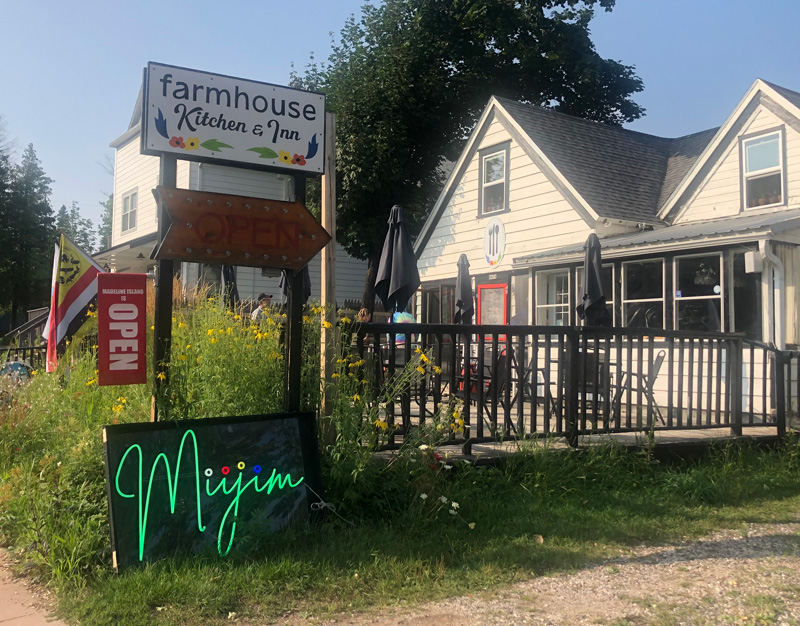Photos by James Norton / Heavy Table except Bryce Stevenson portrait (courtesy of Miijim)
This story originally appeared in Heavy Table’s Tap newsletter on Sep. 1, 2023. To get the Tap and Heavy Table’s other three newsletters, back the magazine on Patreon.
LA POINTE, MADELINE ISLAND, WISC. — Summer vacation this year brought my family to Wisconsin’s South Shore of Lake Superior, where we stayed in a lovely AirBnB that was distressingly close to scenic but steep cliffs overlooking the lake. If you’ve eaten in that part of the world, you probably know that your options are limited, mostly ranging from rustic bar fare to aggressively priced farm-to-table-ish stuff aimed squarely at the tourist trade. Many restaurants are open Thursday through Sunday, making dining a challenge if you don’t happen to be in that part of the world over a weekend.
We got a few lunches, ranging from serviceable (Manypenny Bistro in Bayfield) to not-so-serviceable (Little Nikki’s in Cornucopia) to actually pretty good (Santa Leyenda in Washburn.)
But the meal of the trip was surely at the indigenous restaurant Miijim, a self-described Indigenous Restaurant operating in the Farmhouse Restaurant space in La Pointe, the hub of Madeline Island. La Pointe is a quick and scenic 15-minute ferry trip away from Bayfield, and it’s a place with old resonance for the region – Lake Superior Ojibwe bands knew Madeline Island as a place of spiritual power, and it was inhabited for hundreds of years before the arrival of European settlers in the late 17th Century.

Miijim’s chef, Bryce Stevenson, weaves together some of the sense of place and history into a nonetheless thoroughly modern and sophisticated menu. Stevenson hails from the nearby Red Cliff band of Lake Superior Chippewa but got his culinary start in Milwaukee, Wisc., while attending the University of Wisconsin-Milwaukee in the late teens. On a lark he started working at Hello Falafel, a (now-closed) sister restaurant to Odd Duck, but found that the experience changed him. “Everything was made from scratch, every pickle, falafel ball, everything was made 100% from scratch,” says Stevenson. “That blew my mind. I grew up on commodities, opening cans, mixing egg powder, you know? When I first got into cooking real food, it – everything started blowing up in my mind. All these sparks of ideas, and pathways – ‘there’s a lot I can do with this.’”
“At the same time, I was on my last semester of college and my Indigenous Studies – Meg Noodin was the head of the program [at University of Wisconsin-Milwaukee] and my professor for a lot of classes,” recalls Stevenson. “And she would ask me: ‘All that you’re learning, all this knowledge you’re absorbing, how are you going to bring it back to your people?’ It was the perfect synchronicity of ‘how are you going to bring this back to your people’ and me making food and falling in love with the whole process.”
Miijim’s menu draws heavily from a pantry of pre-colonial ingredients, like Sean Sherman’s restaurant Owamni in Minneapolis. There’s no gluten, dairy, or refined sugar on the menu at Miijim notes Stevenson. But it parts ways with Owamni in embracing the local Ojibwe history of intermarriage with French settlers. “We’ll bring in things that aren’t Indigenous, but it has the same spirit as an Indigenous ingredient, like French lentils,” says Stevenson. “We use a lot of wine for cooking, when we’re braising. […] I want to put that French soul in there, so we can use techniques from that culinary tradition and not feel so boxed in.”
Miijim opened this year over Memorial Day weekend and will take over the Farmhouse restaurant space as owners Lauren Schuppe and Gip Matthews move on to other projects. While part of Miijim’s origin story is the practical nature of obtaining rare restaurant space in an area with little available, part of it too is the history of Madeline Island itself. Stevenson notes: “The real culture and spiritual connection to Madeline Island is the history – this is an Ojibwe island. It’s one of our most sacred places. We were moved [by treaty], but Chief Buffalo secured land on the mainland, which is now Red Cliff. It’s our homeland, Mecca, whatever you want to call it.”
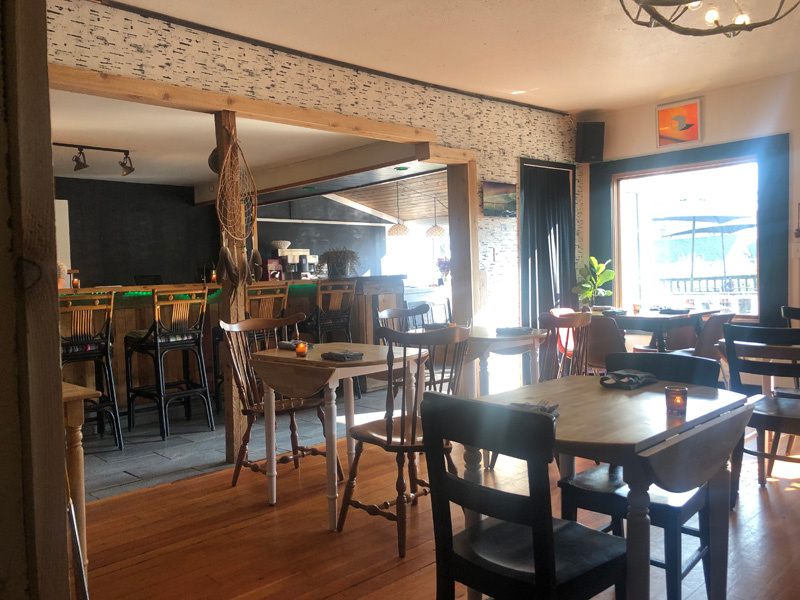
Miijim’s dining room is calm, minimalist, and welcoming; it doesn’t feel out of place with the island’s rustic character, but it also feels of a piece with ambitious modern restaurants worldwide. The menu was appropriately short and driven heavily by seasonal and local ingredients, everything from Lake Superior trout to chanterelle mushrooms to the famous “Three Sisters” made appearances.
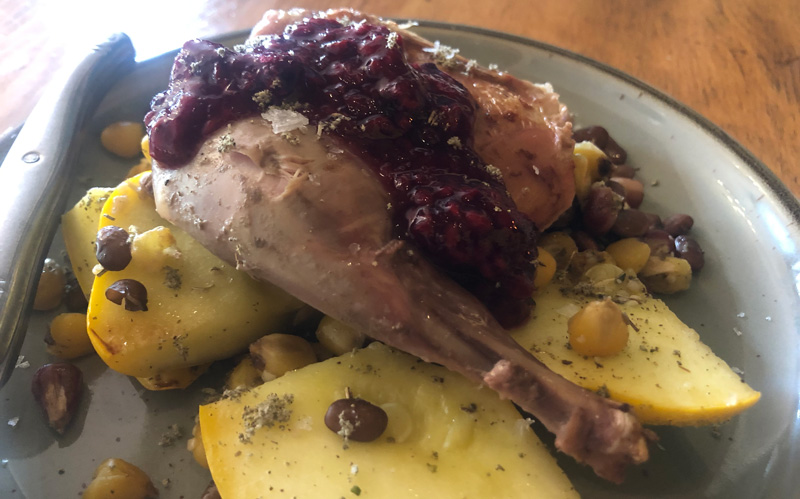
Miijim’s Braised Rabbit Leg ($32) evoked bold, bright flavors by taking advantage of the sweetness of maple syrup and the bright, sunny bite of the berries, both of which played against the mellow fatty earthiness of the protein. A minimalist approach to prepping the accompanying corn, squash, and beans kept them firm and lively rather than drowning them in butter or sagging them into paste through over-application of heat.
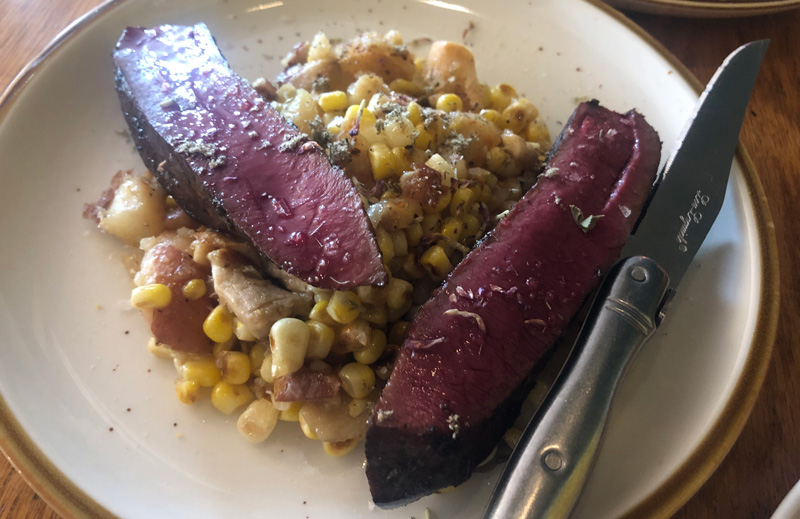
Even better was the restaurant’s Bison Heart Steak ($34). After a few unpleasant run-ins with chicken hearts I’ve mostly tried to stay away from things with ventricles, but it was hard to resist a dish this unusual, and I’m glad that I didn’t. The bison heart was cut into steak-like strips, but it had a springy (but not tough, or rubbery) vitality and deep, bold flavor that put it into its own category of food. The accompanying corn popped with sweetness, and grabbing a bite of the “steak” plus the corn, red potatoes, and oyster mushrooms made for a remarkably complex and compelling experience. “The dish itself is kind of a response to local cuisine in this area,” says Stevenson. “Everything is very much burgers, steaks and potatoes, that mentality. I wanted to do a play on steak and potatoes. The heart itself is something … I grew up eating venison heart my whole life.” Sourcing, says Stevenson, is critical to the dish. “My bison source is Cheyenne River Buffalo in South Dakota, and it’s a tribal company. All the meat that’s processed is from the tribal herds. I’m a big believer in using the weird cuts. I like working with tongue, but I was just talking to Sean Sherman about a tongue dish he was considering and I thought, ‘I don’t want to do a tongue dish too.’ So it was like, ‘let’s get some heart in here and play around with it.’”
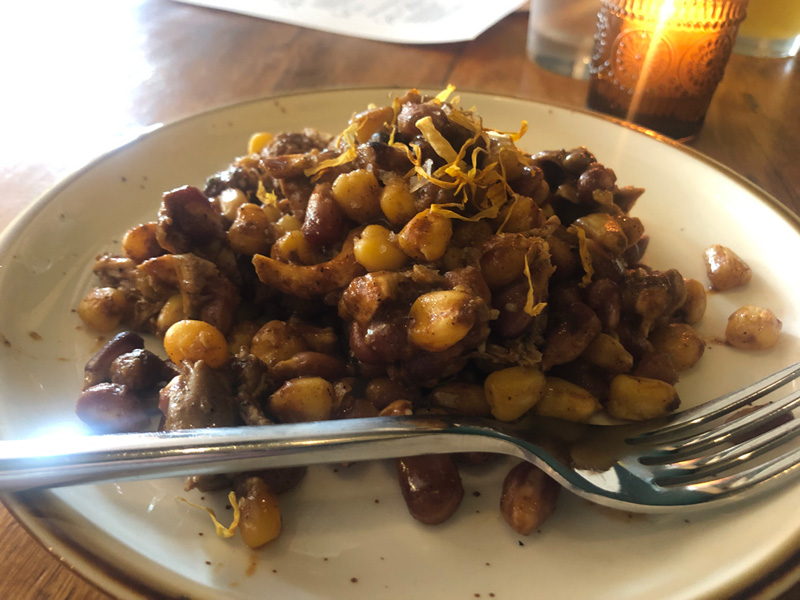
Both vegetable dishes we tried were noteworthy and ambitious – the Wood Ash Hominy ($19, above) popped with texture and was soothingly earthy thanks to the addition of blue oyster mushrooms and a chaga mole. The Tea Boiled Potato ($19) mostly derived its flavor from a small smear of intensely flavored herbal paste on the plate – the dish lacked some richness and impact, which can be tricky to obtain when butter is off the menu.
As the Upper Midwest fights to establish its own culinary identity, innovative Indigenous restaurants like Miijim are a crucial link in the chain. There’s nowhere else on the South Shore that I would insist visitors eat.
Miijim, 858 Main Street, La Pointe, Wisc., 715.331.9860, THU-SAT 5-9pm, SUN 5-8pm

